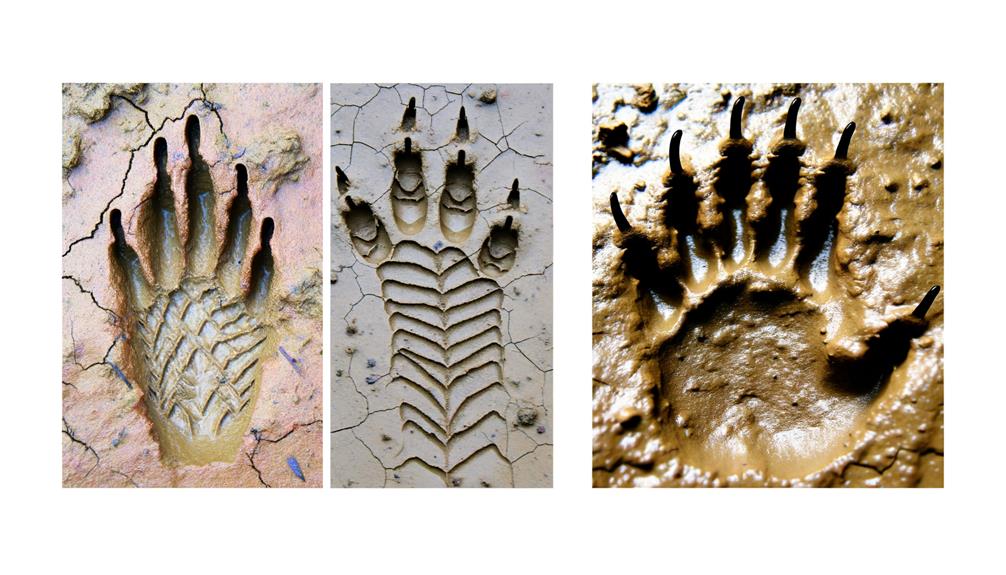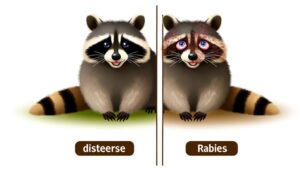10 Key Differences: Fisher Tracks vs Raccoon Tracks
Fisher and Raccoon tracks are distinguishable by their unique animal footprints. Fisher tracks are typically smaller, approximately 1.5 to 2.5 inches, showcasing an asymmetrical layout and zigzag pattern.
They're identifiable by the absence of visible claw marks. Contrarily, raccoon tracks are round, symmetrical, and larger, averaging 3 to 4 inches, with clear claw imprints.
The ability to accurately identify these tracks aids in wildlife tracking, conservational efforts, and ecological understanding. More intricate details about Fisher vs Raccoon tracks lie ahead for those seeking a deeper understanding of wildlife tracking.

Key Takeaways
- Fisher tracks are 1.5 to 2.5 inches wide with a distinctive zigzag pattern, while raccoon tracks are larger, measuring 2-3 inches, and display a 'double stepping' pattern.
- Fisher tracks are asymmetrical with five toes visible, unlike raccoon tracks which are symmetrical and have a hand-like shape with a 'thumb' on their hind feet.
- The claws in Fisher tracks are retractable and may not always be visible, whereas each toe in raccoon tracks is marked by a sharp, non-retractable claw.
- Fisher's stride length ranges from 7-12 inches, exhibiting a bounding gait, whereas raccoons have a wider straddle and shorter stride, yielding a waddling pattern.
- Misidentifications between the two can impact wildlife population estimates and conservation efforts, hence accurate track identification is crucial.
Understanding Animal Tracks
To fully comprehend the intricate differences between fisher tracks and raccoon tracks, a solid understanding of the fundamental principles of animal tracking is essential.
The basis of animal tracking lies in the recognition of track patterns, sizes, and shapes, which are unique to each species. Track patterns are influenced by the animal's size, weight, and mode of locomotion.
The size of the track is often indicative of the animal's size, while the shape can provide clues about the animal's behavior at the time the track was made. The tracks of fishers and raccoons, though similar in some aspects, exhibit distinct differences upon close examination.
Fisher: A Brief Overview
Before identifying the distinct characteristics of their tracks, it's important to gain a basic understanding of the fisher, a medium-sized mammal native to North America.
Scientifically classified as Pekania pennanti, the fisher belongs to the weasel family and is mainly found in dense, coniferous or mixed forests. This elusive creature is renowned for its agility and climbing prowess, often traversing the forest canopy with ease.
Fishers are solitary, primarily nocturnal animals, with a broad diet encompassing small mammals, birds, fruits, and insects. Their fur, a rich dark brown, plays a significant role in their survival, providing insulation against the cold and camouflaging them from predators.
Understanding these aspects of the fisher's biology and ecology is essential for accurate track identification.
Identifying Fisher Tracks
To accurately distinguish Fisher tracks from those of other species, it is essential to understand their unique characteristics.
A detailed analysis of Fisher tracks will reveal certain patterns and measurements that are distinct from other animals, such as raccoons.
Additionally, we will address common misidentifications, equipping readers with the knowledge to accurately identify and differentiate Fisher tracks in various environments.
Characteristics of Fisher Tracks
In the process of identifying Fisher tracks, one must carefully examine certain distinctive characteristics that set these marks apart from others. The unique attributes of these mammalian tracks are derived from their anatomy and locomotion patterns.
Fisher tracks are typically about 2.5 to 3.5 inches long, with five toes and a distinct imprint of the animal's metacarpal pad, which is C-shaped. The claws, though retractable, often leave a mark due to the Fisher's semi-arboreal lifestyle.
The tracks have a zig-zag pattern and exhibit overstep walk, a locomotion style where the hind foot lands ahead of the front foot. These characteristics, along with the distance between prints and track symmetry, can assist in accurate identification.
Comparing Fisher to Other Tracks
Comparison of Fisher tracks with those of other animals, such as raccoons, elucidates significant differences, aiding in the accurate identification and distinction of these unique footprints. Fisher tracks are distinct due to their asymmetrical nature and the presence of five toes on both front and hind feet. In contrast, raccoon tracks generally show a more symmetrical pattern.
Key distinguishing attributes include:
- Fisher tracks often exhibit a unique zigzag pattern, unlike the straighter paths typical of raccoons.
- The size of Fisher tracks typically range from 1.5 to 2.5 inches, larger than the average raccoon footprint.
- Raccoon tracks often show prominent claw marks, which are less visible in Fisher tracks.
Knowing these differences empowers observers with the freedom to confidently identify and respect these creatures in their natural habitat.
Misidentifications of Fisher Tracks
While the differences between Fisher and raccoon tracks are clear, misidentifications can still occur, especially when distinguishing features of Fisher tracks are not properly recognized or understood.
Fisher tracks, characterized by five toes and a lack of prominent claw marks, can often be mistaken for those left by a raccoon due to their similarity in size and shape. However, a key distinguishing feature is the Fisher's asymmetrical footprint, compared to the raccoon's symmetrical ones.
Misidentification can cause errors in population estimates and ecological studies. A basic understanding of the Fisher's distinctive track pattern, including the unique gait and stride, can help avoid misidentifications, ensure precise wildlife tracking, and promote conservation efforts.
Unique Characteristics of Fisher Tracks
Revealing the mystery of Fisher tracks, it's paramount to note their distinct five-toed imprints, which often leaves a zig-zag pattern, a signature of these elusive forest dwellers. The tracks are typically 1.5 to 2.5 inches wide and 1.5 to 3 inches long, a feature that allows scientists to distinguish them from other mammals' tracks.
Further unique characteristics include:
- The asymmetry: Unlike many mammals, Fisher tracks are not symmetrical. The outer toes are often angled towards the direction of movement.
- The claw marks: Fishers have retractable claws, and while they don't always leave marks, when they do, it's a definitive sign of their presence.
- The stride length: Fisher's stride length varies between 7-12 inches, a confirmation of their agile, bounding locomotion.
These features set the Fisher's tracks apart, capturing the essence of their elusive nature.
Raccoon: A Quick Introduction
The raccoon, scientifically known as Procyon lotor, is a medium-sized mammal renowned for its distinctive physical attributes and intelligent, adaptable behaviors.
As we shift from discussing fisher tracks, we will now examine the identifying characteristics and behavioral traits of the raccoon that influence its unique track patterns. Understanding these aspects will provide a thorough foundation for discerning between the track imprints of these two distinct species.
Raccoon Physical Characteristics
Exhibiting a distinctive physical makeup, raccoons possess a robust body covered in thick, insulating fur, a broad head with a pointed snout, and dexterous, nimble paws equipped with sharp claws, attributes that play a pivotal role in their adaptability and survival.
Key physical characteristics of raccoons include:
- Coloration: Raccoons typically exhibit grey to brown fur with a unique black 'mask' around their eyes, providing a distinct contrast that aids in camouflaging in various environments.
- Size: Raccoons can vary greatly in size, with a typical adult ranging from 16 to 28 inches in length, excluding the tail, and weighing between 8 to 20 pounds.
- Sensory Abilities: Raccoons possess an acute sense of touch, amplified by their nimble paws, and a keen sense of hearing and smell, optimizing their ability to locate food and avoid danger.
Raccoon Behavioral Traits
Building upon their physical attributes, raccoons also display a range of behavioral traits that further facilitate their adaptability and survival. Their behavior is largely influenced by their environment, diet, and interactions with other species. Raccoons exhibit intelligence and problem-solving skills, often attributed to their omnivorous diet requiring them to find and manipulate various food sources. Their nocturnal nature aids in evading predators and humans, while their social behavior varies from solitary to group living, depending on resources.
| Behavioral Trait | Description | Impact on Survival |
|---|---|---|
| Intelligence | Problem-solving ability | Enhances food acquisition |
| Nocturnality | Active at night | Decreases predation risk |
| Varied sociality | Solitary or group living | Resource-dependent |
| Adaptability | Versatile in habitat choices | Secures survival in varied environments |
| Curiosity | Investigates new objects | Supports discovery of food sources |
These traits serve as a testament to the raccoon's resilience in a constantly changing world.
Recognizing Raccoon Tracks
In the domain of wildlife tracking, discerning raccoon tracks involves careful observation and analysis of distinctive characteristics such as their size, shape, and pattern. This requires a keen eye and an understanding of the animal's behavior and environment.
To better recognize raccoon tracks, consider the following:
- Raccoons possess five toes on both their front and hind feet. This is a defining feature that sets them apart from other similar-sized mammals.
- The tracks often show evidence of the animal's claws, which are sharp and non-retractable.
- Their walking pattern is distinctive. Raccoons use a pacing gait, which leaves a specific pattern of prints.
Through detailed analysis of these characteristics, one can differentiate raccoon tracks from other species, enhancing your tracking freedom in the wild.
Key Features of Raccoon Tracks
Now, let's take a closer look at the specific features that make raccoon tracks uniquely identifiable. Raccoon tracks are distinct due to their size, shape, and pattern. They are medium-sized, generally 2-3 inches long, with a width roughly equal to their length.
The shape is akin to a human handprint, with five toes displaying in both front and hind prints. The hind prints are slightly larger and longer than the front prints. The pattern is described as a "waddling" gait, with tracks often overlapping.
| Feature | Description | Significance |
|---|---|---|
| Size | 2-3 inches | Medium-sized mammal |
| Shape | Human-like handprints | Five toes in both front and hind prints |
| Pattern | Waddling gait | Tracks often overlap |
A thorough understanding of these features is key for accurate identification in the field.
Fisher Vs Raccoon: Track Comparison
Comparing and contrasting the tracks of fishers and raccoons will elucidate distinct characteristics of each species' footprints.
The identification of fisher tracks will involve a detailed examination of their unique morphology, size, and stride pattern.
Similarly, the recognition of raccoon tracks will be based on their characteristic features, followed by an analytical assessment of the differences between the two species' tracks.
Identifying Fisher Tracks
Distinguishing between fisher and raccoon tracks requires a keen eye and understanding of their unique characteristics. Fisher tracks generally display a more elongated, asymmetrical pattern compared to the wider, symmetrical prints of a raccoon.
In the pursuit of identifying fisher tracks, consider the following points:
- Fisher tracks often feature five toes and a C-shaped heel pad. The toes are arranged in a semi-circular pattern, with the claws often visible.
- Typically, fisher tracks measure around 1.5 to 2.5 inches in width and length, though this can vary based on the individual animal's size.
- Unlike raccoon tracks, fisher tracks generally display a more haphazard, irregular pattern of movement.
Recognizing Raccoon Tracks
Turning our attention to raccoon tracks, it's vital to observe their distinctive characteristics that differentiate them from fisher tracks. Raccoon tracks are typically about 2-3 inches in length, roundish in shape and display a unique 'double stepping' pattern where the hind foot often lands on top of the front foot mark.
The track's most distinguishable trait, however, lies in its five long, thin and pointed toes, with the innermost toe slightly smaller than the rest. Each toe is marked by a sharp, non-retractable claw. The palm pad is C-shaped, which helps in gripping.
These unique impressions left by a raccoon's paws are an unmistakable sign of their presence, offering an insightful glimpse into their terrestrial locomotion habits.
Track Differences Explained
In analyzing the differences between fisher and raccoon tracks, it becomes evident that these distinctions are not only stark but also quite informative about their respective behaviors and adaptations.
- Fishers generally leave tracks that are more elongated and asymmetrical compared to raccoons. Fishers' tracks often exhibit a zigzag pattern, indicative of their bounding gait.
- Raccoon tracks, in contrast, are typically rounder, with the front and rear paws displaying a noticeable size difference. Their tracks often show a waddling pattern, reflecting their ambulatory movement.
- Additionally, the number and arrangement of the toes in the tracks provide further distinction. Fishers have five toes on their hind and front feet, while raccoons exhibit a clear 'thumb' on their hind feet.
These nuances in track characteristics offer valuable insight into their distinct locomotion styles, survival strategies, and ecological niches.
Common Misconceptions About Tracks
Numerous misconceptions abound when it comes to identifying and differentiating between fisher tracks and raccoon tracks, often leading to inaccurate conclusions about the presence of these creatures in a specific area.
A common fallacy is that a larger track size automatically signifies a fisher. However, careful examination reveals that raccoons, despite being smaller, can leave broader, more robust impressions due to their distinctive walking pattern.
Another prevalent error is the misinterpretation of claw marks. While both species have sharp claws, raccoons' are more prominent than fishers'. This misidentification could mislead individuals into believing they're dealing with an invasion of fishers, when it's merely a raccoon.
Such errors impede accurate analysis and potentially influence decision-making regarding wildlife management.
Helpful Tips for Track Identification
To accurately identify whether a track belongs to a fisher or a raccoon, a detailed understanding of their respective footprints is indispensable.
The following tips can be instrumental in track identification:
- Size: Raccoon tracks are generally larger, with adult prints measuring about 3 to 4 inches long. Fisher tracks, on the other hand, are smaller, typically around 1.5 to 2.5 inches long.
- Shape: Raccoon footprints display a unique hand-like shape with five long toes, while fisher tracks have a more rounded appearance, showcasing four shorter toes.
- Stride and Straddle: This refers to the patterns and distances between tracks. Raccoons have a wider straddle and shorter stride, fishers exhibit a narrow straddle and longer stride.
Importance of Animal Track Knowledge
Mastering the art of animal track identification not only enhances human understanding of wildlife behaviors and habitats, but also plays a pivotal role in conservation efforts and ecological research. The ability to distinguish between, say, fisher and raccoon tracks, may contribute significantly to understanding the distribution of these species, their interaction with the environment and each other.
In addition, it aids in monitoring population trends, detecting the presence of invasive species, and implementing timely, targeted conservation actions. Knowledge of animal tracks can also be instrumental in outdoor safety, facilitating informed decisions when encountering wildlife.
Consequently, this knowledge liberates us, fostering a harmonious coexistence with nature while empowering us to protect and preserve our ecosystems.
Conclusion
To sum up, the ability to differentiate between fisher and raccoon tracks is an essential skill for wildlife enthusiasts, researchers, and hunters. This knowledge allows for a deeper understanding of these species' behavior, habitat, and contribution to their ecosystem.
By debunking common misconceptions and highlighting the unique characteristics of each track, we can enhance our appreciation for these fascinating creatures and further promote their conservation.






